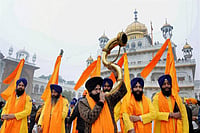“An Artist has no Caste": Chinki Sinha in conversation with Madhubani artist Shanti Devi
Not so long ago, Shanti Devi, a Madhubani artist, had no pucca house. She had been married at a young age and remembers her struggles to even paint. “I was chased by an upper caste man when I tried to paint scenes from Ramayana,” she says. Shanti Devi, who belongs to the Paswan caste that comes under the Scheduled Caste category, says artists like her who were the so-called “untouchables” in the Mithila region weren’t allowed to paint gods and goddesses. She had called a panchayat in her village many years ago to stress upon her freedom as an artist. “An artist has no caste,” she says. But freedom doesn’t come easy. She is a woman and for women, freedom is still a dream. “There is that patriarchy that cuts across caste and class and I have seen how it can torment you,” she says. In an interview with Outlook at the Bihar Museum where she was part of a contingent of 30 artists who are practitioners of folk art forms of Bihar, she says she decided to paint a scene from Ashok Vatika where Sita had been held captive. Vaidehi Sita was curated as an ode to Sita from Ramayan at the Bihar Museum. “Sita was powerful. She suffered. She was abandoned and she chose to return to nature and not suffer more indignities. That’s why I have painted the garden so beautifully,” Shanti Devi says. “Sita came from earth. And by returning to it, she freed herself.”

















.png?w=200&auto=format%2Ccompress&fit=max)







